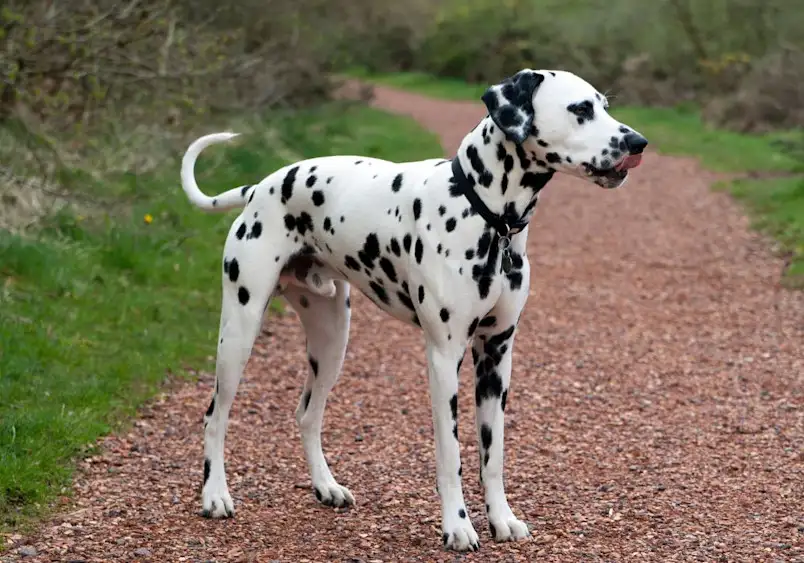Quick take: Yes—under the right home. Dalmatians are athletic, playful, people-oriented, and loyal. They thrive with daily vigorous exercise, early training, and consistent socialization. In lower-activity households or where dogs are left alone all day, they can develop unwanted behaviors.
Group/role: Historic coach (carriage) dog; closely associated with fire brigades
Personality: Energetic, intelligent, devoted, watchful, social
Energy level: Very high (needs real outlets daily)
Good with kids? Often yes—when well socialized and supervised; can be too boisterous for toddlers
Size: 19–24 in (48–61 cm); 45–70 lb (20–32 kg)
Coat/colour: Short, dense; black or liver spots on white (the only true “spotted” breed)
Life span: ~11–14 years (with good care)

Playful companions: Most love games, jogs, hikes, and fetch.
People-focused: Bond closely with their households and enjoy being included.
Trainable & smart: Respond well to positive reinforcement, food/toy rewards, and clear structure.
Watchful (not typically aggressive): Will alert-bark; usually settle when introduced properly.
Low odor, simple grooming: Short coat; no trims required.
Exercise requirements: Expect 60–90+ minutes of purposeful activity every day (walks + off-leash zooms in secure areas, running next to a bike for adults, scent games, structured play).
Mental stimulation: Without enrichment (training games, puzzle feeders, scentwork), intelligent dogs may invent their own fun: digging, chewing, door-dashing.
Mouthy/rowdy if under-exercised: High arousal can lead to jumping, nipping, barking.
Shedding: Year-round; short, stiff hairs stick in fabrics.
Health hotspots:
Hearing loss: A notable proportion of puppies show unilateral or bilateral deafness. Reputable breeders BAER-test litters ~7–8 weeks.
Uric-acid metabolism (hyperuricosuria/hyperuricemia): Tendency toward urate bladder/kidney stones, especially in males; managed via hydration, frequent potty breaks, and appropriate veterinary-guided diet (often moderate/low purine).
Weight gain in low-exercise homes.
Alone time: Many don’t do well with full-workday isolation without a plan (walker, daycare, or structured breaks).
Children: Typically patient and playful when socialized; teach kids calm handling. Because Dalmatians are fast and physical, close supervision with small children is essential.
Dogs: Often enjoy canine play if introduced early; may be selective without socialization.
Cats/small pets: Varies—introduce with care; use management and training.
| Fit Factor | Best for | Might Not Suit |
|---|---|---|
| Daily time & energy | Active families, runners, hikers, sporty teens | Low-activity homes; no time for training/exercise |
| Schedule | People home some of the day or with care plan | 9–10 hr daily isolation without breaks |
| Experience | First-time owners who will take a class | Owners opposed to training structure |
| Children | School-age kids used to dogs | Households with fragile toddlers + no management |
| Grooming tolerance | Okay with year-round shedding | Want truly low-shed clothes/furniture |
Daily: 2 brisk leash walks (20–30 min each) + one energy outlet (fetch/long-line sprint/scent games)
3–4×/week: Training sessions (10–15 min: recall, settle on mat, loose-leash, impulse control)
2×/week: Dog sports sampler—canicross, bike-jor (adult dogs), rally-obedience, nosework, agility foundations
Always: Food-puzzle rotation (Kong, snuffle mat, lick mat, frozen toppers)
Brushing: Rubber curry or grooming glove 2–3×/week (daily in peak shed).
Bathing: Every 6–8 weeks or as needed.
Nails/ears/teeth: Nails every 2–4 weeks; routine ear checks; daily or several-times-weekly tooth brushing.
Fur management: Lint rollers, upholstery brush, and a vacuum with a pet-hair tool are your friends.
BAER hearing test documentation for puppies/parents.
Discuss urate stone risk management (diet guidance, water access, prompt potty breaks).
Standard breed health checks per veterinary guidance (hips, eyes, thyroid where relevant).
Return-to-breeder/rescue contract and lifetime support.
Veterinary note (not medical advice): Work with your vet on hydration strategies (multiple water stations, wet food/toppers), regular urine opportunities, and a vet-recommended diet if your dog is at risk for urate issues.
Crate + baby gates for management/safe rest
Leash, long line, front-attach harness
ID & microchip (with current contact info)
Food puzzles & chew rotation
Training class booking (reward-based)
Exercise plan shared by all family members
Vacuum/lint tools for shedding reality
Are Dalmatians aggressive?
They’re not inherently aggressive. Without socialization, outlets, and training, any energetic working breed can develop reactivity (barking, nipping). Structure + exercise = success.
Are they good apartment dogs?
Yes if you commit to daily cardio + brain work and quick access to outdoor breaks. Elevators and hallways double as training opportunities.
How much do they shed?
A lot—short, stiff hairs year-round. Regular brushing and good housekeeping tools help.
Can a Dalmatian be left alone?
Plan for gradual alone-time training and midday breaks. Many struggle with full-day isolation without enrichment.
What about deaf Dalmatians?
Deaf dogs can live great lives with hand signals, vibration cues, and modern training; consider a trainer experienced with hearing-impaired dogs.
animal tags: dalmations
We created this article in conjunction with AI technology, then made sure it was fact-checked and edited by a Animals Top editor.